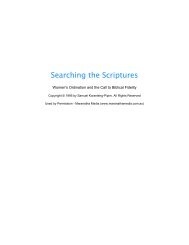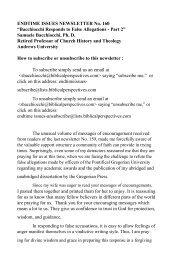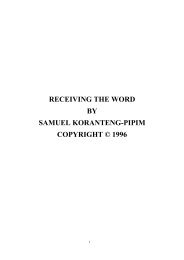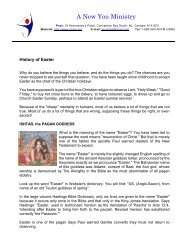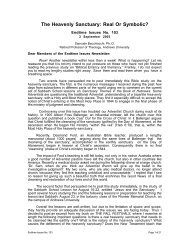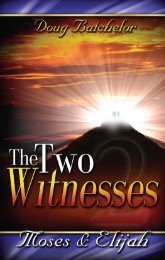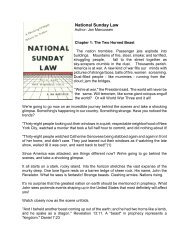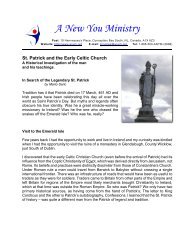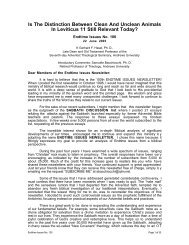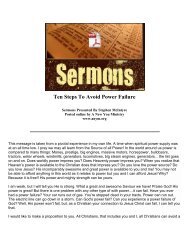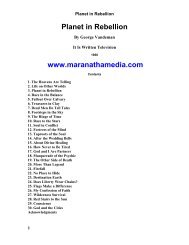Bible Readings for the Home Circleâ1914 - A New You Ministry
Bible Readings for the Home Circleâ1914 - A New You Ministry
Bible Readings for the Home Circleâ1914 - A New You Ministry
You also want an ePaper? Increase the reach of your titles
YUMPU automatically turns print PDFs into web optimized ePapers that Google loves.
BIBLE READINGS<br />
have been increasing since <strong>the</strong>n. “In that year,” says Mr. Guinness in<br />
his work “Romanism and <strong>the</strong> Re<strong>for</strong>mation,” page 156, “<strong>the</strong> Papacy<br />
assumed <strong>the</strong> highest exaltation to which it could aspire, that of infallibility.”<br />
To such a position of influence over <strong>the</strong> nations is <strong>the</strong> Papacy<br />
finally to attain that just be<strong>for</strong>e her complete overthrow and destruction<br />
she will say, “I sit a queen, and am no widow, and shall see no<br />
sorrow.” Rev. 18:7. See Isa. 47:7–15; Rev. 17:18.<br />
6. What is said concerning <strong>the</strong> captivity and downfall of <strong>the</strong> Papacy<br />
“He that leadeth into captivity shall go into captivity: he that killeth<br />
with <strong>the</strong> sword must be killed with <strong>the</strong> sword.” Verse 10. See Ps. 18:25,<br />
26; 109:17; Jer. 50:29; Rev. 16:4–6.<br />
7. What questions asked by its worshipers indicate <strong>the</strong> great station<br />
to which this beast-power was to attain<br />
“And <strong>the</strong>y worshiped <strong>the</strong> dragon which gave power unto <strong>the</strong> beast:<br />
and <strong>the</strong>y worshiped <strong>the</strong> beast, saying, Who is like unto <strong>the</strong> beast who is<br />
able to make war with him” Rev. 13:4.<br />
8. How universal is <strong>the</strong> worship of this power to become<br />
“And all that dwell upon <strong>the</strong> earth shall worship him, whose names are<br />
not written in <strong>the</strong> book of life of <strong>the</strong> Lamb slain from <strong>the</strong> foundation of <strong>the</strong><br />
world.” Verse 8.<br />
9. What did John say was to be <strong>the</strong> end of this beast<br />
“And <strong>the</strong> beast was taken, and with him <strong>the</strong> false prophet that wrought<br />
miracles be<strong>for</strong>e him. . . . These both were cast alive into a lake of fire<br />
burning with brimstone.” Rev. 19:20. See Isa. 47:7–15; 2 Thess. 2:3–8;<br />
Rev. 17:16, 17; 18:4–8.<br />
10. In what similar language is <strong>the</strong> fate of <strong>the</strong> fourth beast of Daniel<br />
7 described<br />
“I beheld <strong>the</strong>n because of <strong>the</strong> voice of <strong>the</strong> great words which <strong>the</strong> horn<br />
spake: I beheld even till <strong>the</strong> beast was slain, and his body destroyed, and<br />
given to <strong>the</strong> burning flame.” Dan. 7:11.<br />
MAKING AN IMAGE TO THE BEAST<br />
THE PROPHECY OF REVELATION 13<br />
{271<br />
271}<br />
1. WHEN was <strong>the</strong> papal head of <strong>the</strong> first beast of Revelation 13<br />
wounded<br />
In 1793–98, by <strong>the</strong> French Revolution, and <strong>the</strong> temporary overthrow<br />
of <strong>the</strong> Papacy in <strong>the</strong> latter year.<br />
MAKING AN IMAGE TO THE BEAST<br />
2. What did <strong>the</strong> prophet see coming up at this time<br />
“And I beheld ano<strong>the</strong>r beast coming up out of <strong>the</strong> earth; and he had<br />
two horns like a lamb, and he spake as a dragon.” Rev. 13:11.<br />
NOTES.— Mr. Wesley, in his notes on Revelation 13, written in 1754,<br />
says of <strong>the</strong> two-horned beast: “He is not yet come, though he cannot<br />
be far off; <strong>for</strong> he is to appear at <strong>the</strong> end of <strong>the</strong> <strong>for</strong>ty-two months of <strong>the</strong><br />
first beast.”<br />
The previous beast came up out of <strong>the</strong> “sea,” which indicates its<br />
rise among <strong>the</strong> peoples and nations of <strong>the</strong> world <strong>the</strong>n in existence<br />
(Rev. 17:15); while this one comes up out of <strong>the</strong> “earth.” This would<br />
indicate that <strong>the</strong> latter beast would arise where <strong>the</strong>re had not be<strong>for</strong>e<br />
been “peoples, and multitudes, and nations, and tongues.” In 1798,<br />
when <strong>the</strong> papal power received its deadly wound, <strong>the</strong> government of<br />
<strong>the</strong> United States, located in <strong>the</strong> western continent, was <strong>the</strong> only great<br />
and independent nation <strong>the</strong>n coming into prominence in territory not<br />
previously occupied by peoples, multitudes, and nations. Only nine<br />
years preceding this (1789), <strong>the</strong> United States adopted its Constitution.<br />
It is within <strong>the</strong> territory of <strong>the</strong> United States, <strong>the</strong>re<strong>for</strong>e, that we<br />
may look, according to <strong>the</strong> prophecy, <strong>for</strong> an ecclesiastical movement<br />
to arise, and exert dominating control, not only in <strong>the</strong> civil government<br />
of this country, but also in <strong>the</strong> o<strong>the</strong>r nations of <strong>the</strong> whole world as well.<br />
{273<br />
273}<br />
3. What is <strong>the</strong> character of this new power<br />
“He had two horns like a lamb.” Rev. 13:11.<br />
NOTE.— The Pilgrim Fa<strong>the</strong>rs were <strong>the</strong> vanguard of a great multitude of<br />
Protestants, who, when persecuted and outlawed in <strong>the</strong> lands of <strong>the</strong>ir<br />
birth, sought refuge in <strong>the</strong> <strong>New</strong> World, where <strong>the</strong>y developed rapidly<br />
under <strong>the</strong> protection of a government founded on <strong>the</strong> great Christian<br />
principles of civil and religious freedom. The two horns may well symbolize<br />
<strong>the</strong>se two fundamental principles.<br />
4. Notwithstanding <strong>the</strong> lamblike appearance of this power, what is it<br />
ultimately to do<br />
“And he spake as a dragon.” Rev. 13:11.<br />
NOTES.— The voice of <strong>the</strong> dragon is <strong>the</strong> voice of intolerance and<br />
persecution. This indicates that <strong>the</strong> ecclesiastical development dealt<br />
with in this prophecy, obtaining a foothold <strong>for</strong> its initial power and<br />
influence in <strong>the</strong> government of <strong>the</strong> United States, will repudiate <strong>the</strong><br />
mild and lamblike principles of civil and religious liberty, and become<br />
like <strong>the</strong> world-wide persecuting power. This is why in Rev. 19:20 it is<br />
called “<strong>the</strong> false prophet.” Born of <strong>the</strong> Re<strong>for</strong>mation, it will repudiate<br />
Re<strong>for</strong>mation principles.<br />
5. How much power will this beast exercise<br />
“And he exerciseth all <strong>the</strong> power of <strong>the</strong> first beast be<strong>for</strong>e him, and




